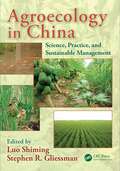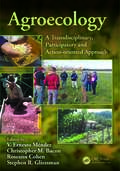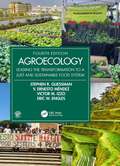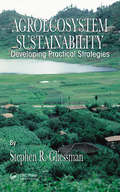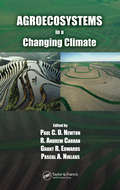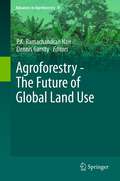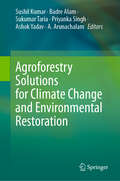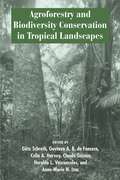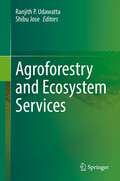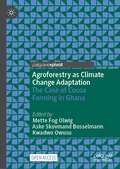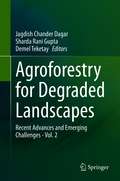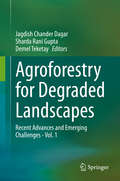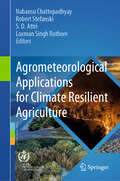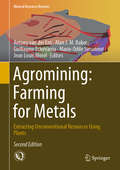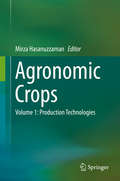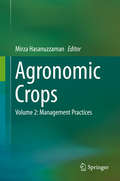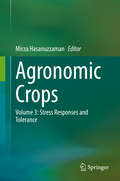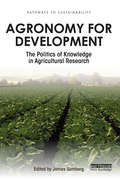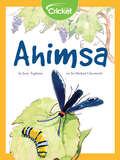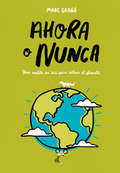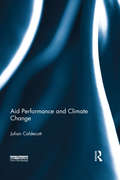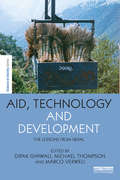- Table View
- List View
Agroecology in China: Science, Practice, and Sustainable Management (Advances in Agroecology #22)
by Stephen R. Gliessman Luo ShimingKey features: Reviews the development of agroecology in China, including research, practice, management, and education regarding challenges for rural and agricultural progress Presents information from sources not readily available in the West about agricultural development in China during the last several decades Provides models and indicates starting points for future research and practice Addresses how to meet future challenges of agroecosystems from the field to the table in China from scientific, technological, and management perspectives During the past 30 years, industrialization has fundamentally changed traditional rural life and agricultural practices in China. While the incomes of farmers have increased, serious issues have been raised concerning the environment, resource depletion, and food safety. In response, the Chinese government and Chinese scientists encouraged eco-agriculture, the practice of agroecology principles and philosophy, as a way to reduce the negative consequences of large-scale industrialized systems of farming. Agroecology in China: Science, Practice, and Sustainable Management represents the work of experts and leaders who have taught, researched, and expanded Chinese agroecology and eco-agriculture for more than 30 years. It reviews decades of agricultural change to provide an integrated analysis of the progress of research and development in agroecological farming practices. The book contains research on traditional and newly developed agricultural systems in China, including intercropping systems, rainfall harvest systems, and rice–duck, rice–fish, and rice–frog co-culture systems. It covers current eco-agriculture practices in the major regions of China according to climate conditions. The book closes with a discussion of the major technical approaches, necessary policy support, and possible major development stages that must occur to allow broader agroecological implementations toward the sustainability of future food systems in China. Presenting eco-agriculture systems that are somewhat unique in comparison to those of the United States, Latin America, and Europe, Agroecology in China gives insight on how Chinese agroecologists, under the political and cultural systems specific to China, have created a strong foundation for ecologically sound agroecosystem design and management that can be applied and adapted to food systems elsewhere in the world. By using selected regional examinations of agroecological efforts in China as examples, this book provides models of how to conduct research on a broad range of agroecosystems found worldwide.
Agroecology: A Transdisciplinary, Participatory and Action-oriented Approach (Advances in Agroecology)
by Stephen R. Gliessman Christopher M. Bacon Roseann Cohen V. Ernesto MéndezAgroecology: A Transdisciplinary, Participatory and Action-oriented Approach is the first book to focus on agroecology as a transdisciplinary, participatory, and action-oriented process. Using a combined theoretical and practical approach, this collection of work from pioneers in the subject along with the latest generation of acknowledged leaders
Agroecology: Leading the Transformation to a Just and Sustainable Food System (Advances in Agroecology)
by Stephen R. Gliessman V. Ernesto Méndez Victor M. Izzo Eric W. EnglesAgroecology is at the forefront of transforming our food systems. This bestselling textbook provides the essential foundation for understanding this transformation in all its components: agricultural, ecological, economic, social, cultural, and political. It presents a case for food system change, explains the principles and practices underlying the ecological approach to food production, and lays out a vision for a food system based on equity and greater compatibility with the planet’s life support systems. New to the fourth edition: A chapter on Alternatives to Industrial Agriculture, covering the similarities and distinctions among different approaches to sustainable agriculture A chapter on Ecological Pest, Weed, and Disease Management A chapter on Urban and Peri-urban Agriculture A chapter on Agriculture and the Climate Crisis A revised analysis and critique of the food system’s embeddedness in the extractive capitalist world economy that reflects ideas in the emerging field of political agroecology. Streamlined treatment of agroecology’s foundations in ecological science, making the text more compatible with typical course curricula. A Companion Website incorporates the entire contents of the updated practical manual Field and Laboratory Investigations in Agroecology, split into student and lecturer resources. These 24 sample investigations facilitate hands-on learning that involves close observation, creative interpretation, and constant questioning of findings. Groundbreaking in its first edition and established as the definitive text in its second and third, the fourth edition of Agroecology captures recent developments in the field and forcefully applies the idea that agroecology is a science, a movement, and a practice. Written by a team of experts, this book will encourage students and practitioners to consider the critical importance of transitioning to a new paradigm for food and agriculture.
Agroecology: Sustainable Ecosystem
by Anand M. R. Poojitha Kommireddy Seenappa C. Kalyana Murthy K. N. Ningaraju G. K.Agroecology literacy is 'the degree to which people have an objective and well-informed understanding of crop production with environmental issues.' The increased food grain production has also increased the unscientific and indiscriminate use of agrochemicals which has affected the soil health and degraded agroecosystem adversely and brought down the immunity of soil and the productivity of crops. In addition, it has resulted in the over-exploitation of soil, leading to nutrient imbalance. Moreover, the negative impact of chemical agriculture on the environment and human health has been reported and documented. Increased environmental awareness and health consciousness promoted scientists and planners to think about sustainable farming practices as an alternate way for healthy agriculture to protect the environment and human health. Eco-friendly methods or ecosystem services are one solution to manage this issue. This book intends to provide the core elements of a curriculum for teaching agroecology at colleges and universities. Print edition not for sale in India.
Agroecosystem Sustainability: Developing Practical Strategies
by Stephen R. GliessmanAgroecologists from around the world share their experiences in the analysis and development of indicators of agricultural sustainability in Agroecosystem Sustainability: Developing Practical Strategies. The authors build on the resource-conserving aspects of traditional, local, and small-scale agriculture while at the same time drawing on modern e
Agroecosystems in a Changing Climate
by Paul C. D. Newton R. Andrew Carran Grant R. Edwards Pascal A. NiklausAgroecosystems in a Changing Climate considers the consequences of changes in the atmosphere and climate on the integrity, stability, and productivity of agroecosystems. The book adopts a novel approach by bringing together theoretical contributions from ecologists and the applied interpretations of agriculturalists. Drawing these two approa
Agroforestry - The Future of Global Land Use (Advances in Agroforestry #9)
by P.K. Ramachandran Nair Dennis GarrityThis volume contains a solid body of the current state of knowledge on the various themes and activities in agroforestry worldwide. It is organized into three sections: the Introduction section consists of the summaries of six keynote speeches at the 2nd World Congress of Agroforestry held in Nairobi, Kenya, in 2009; that is followed by two sections of peer-reviewed thematic chapters grouped as "Global Perspectives" (seven chapters) and "Regional Perspectives" (eleven chapters), authored by professional leaders in their respective agroforestry-related fields worldwide. A total of 130 professionals from institutions in 33 countries in both developing and the industrialized temperate regions of the world contributed to the book as chapter authors and/or reviewers. Thus, the book presents a comprehensive and authoritative account of the global picture of agroforestry today.
Agroforestry Solutions for Climate Change and Environmental Restoration
by Sushil Kumar A. Arunachalam Priyanka Singh Badre Alam Sukumar Taria Ashok YadavThis book discusses the possibilities, reach, challenges, and limitations of agroforestry in new contexts where the security of food, nutrition, and the environment are equally vital. The focus of each chapter in the book is on the potential for agroforestry to address pressing issues such as sustainability, food, fodder, nutrition, and environmental security, as well as to offer, support, regulate, and to provide cultural services to society. Some of the devoted chapters in the book also go into detail on the scope and restrictions of agroforestry owing to existing regional and climatic barriers/problems, in addition to in-depth discussion of prospects of agroforestry in changed climate scenarios to cater to current and future needs. The major focus of this book is to aggregate up-to-date and recent agroforestry research studies/achievements to make them accessible to all the stakeholders for their use and to disseminate how agroforestry systems are playing a crucial role in tackling many difficulties during the changing climate and environmental crisis. The stakeholders find this book helpful in learning agroforestry and its importance in situations with changing climatic conditions across the globe. Additionally, it may also be helpful for policy makers for formulating policies pertaining to the adaptation and mitigation of climate change, the conservation of natural resources, and food and nutritional security, including sustainable development through agroforestry.
Agroforestry and Biodiversity Conservation in Tropical Landscapes
by Anne-Marie N. Izac Claude Gascon Götz Schroth Celia A. Harvey Gustavo A. B. da Fonseca Heraldo L. VasconcelosAgroforestry -- the practice of integrating trees and other large woody perennials on farms and throughout the agricultural landscape -- is increasingly recognized as a useful and promising strategy that diversifies production for greater social, economic, and environmental benefits. Agroforestry and Biodiversity Conservation in Tropical Landscapes brings together 46 scientists and practitioners from 13 countries with decades of field experience in tropical regions to explore how agroforestry practices can help promote biodiversity conservation in human-dominated landscapes, to synthesize the current state of knowledge in the field, and to identify areas where further research is needed. Agroforestry and Biodiversity Conservation in Tropical Landscapes is the first comprehensive synthesis of the role of agroforestry systems in conserving biodiversity in tropical landscapes, and contains in-depth review chapters of most agroforestry systems, with examples from many different countries. It is a valuable source of information for scientists, researchers, professors, and students in the fields of conservation biology, resource management, tropical ecology, rural development, agroforestry, and agroecology.
Agroforestry and Ecosystem Services
by Shibu Jose Ranjith P. UdawattaThis book is a state-of-the-art compilation of the latest information on ecosystem services of agroforestry. The last two decades have seen a surge in literature on the ecosystem services of sustainable agriculture practices, including that of agroforestry; however, compilation and synthesis of such information from agroforestry have been limited. This book fills that void by bringing in a number of experts from around the world. In addition to presenting the multiple dimensions of ecosystem services provided by major agroforestry practices, the book also offers case studies from both tropical and temperate regions of the world.Information from this book can be used to design land management practices for climate change mitigation, ecosystem benefits, agricultural productivity and sustainability, and for survival and profitability of family farms and to conserve biodiversity. While synthesizing information of the biophysical aspects of ecosystem services, the book also outlines the socioeconomic and policy dimensions, including appropriate incentive models to enhance adoption of agroforestry so that society at large can enjoy these important benefits
Agroforestry as Climate Change Adaptation: The Case of Cocoa Farming in Ghana
by Mette Fog Olwig Aske Skovmand Bosselmann Kwadwo OwusuThis open access book provides multidisciplinary perspectives on the potential of agroforestry to mitigate the negative impacts of climate change on cocoa production. Against the backdrop of increasingly precarious farmer livelihoods, it focuses on cocoa-agroforestry in Ghana – the second largest producer of cocoa in the world. Taking the reader on a journey across experimental plots and on-farm studies, the book delivers a holistic understanding of cocoa-agroforestry. Chapters examine historical yield and climate interactions, the effects of heat and drought on cocoa plants and the role of differing shade trees on soil fertility, yields, pests and diseases. The book discusses the socioeconomics of shade tree management, including cost-benefits, tree rights and competition for natural resources emphasizing policy implications and recommendations.Taking a multidisciplinary approach to climate-agriculture interactions, the book provides an innovative understanding of agroforestry and perennial cropping systems that goes beyond the Ghanaian cocoa belt. It is of relevance to students, researchers, farmers, practitioners and policymakers working with agroforestry and climate change adaptation.This is an open access book.
Agroforestry for Degraded Landscapes: Recent Advances and Emerging Challenges - Vol. 2
by Jagdish Chander Dagar Sharda Rani Gupta Demel TeketayThis book presents various aspects of agroforestry research and development, as well as the latest trends in degraded landscape management. Over the last four decades, agroforestry research (particularly on degraded landscapes) has evolved into an essential problem-solving science, e.g. in terms of sustaining agricultural productivity, improving soil health and biodiversity, enhancing ecosystem services, supporting carbon sequestration and mitigating climate change. This book examines temperate and tropical agroforestry systems around the world, focusing on traditional and modern practices and technologies used to rehabilitate degraded lands. It covers the latest research advances, trends and challenges in the utilization and reclamation of degraded lands, e.g. urban and peri-urban agroforestry, reclamation of degraded landscapes, tree-based multi-enterprise agriculture, domestication of high-value halophytes, afforestation of coastal areas, preserving mangroves and much more. Given its scope, the book offers a valuable asset for a broad range of stakeholders including farmers, scientists, researchers, educators, students, development/extension agents, environmentalists, policy/decision makers, and government and non-government organizations.
Agroforestry for Degraded Landscapes: Recent Advances and Emerging Challenges - Vol.1
by Jagdish Chander Dagar Sharda Rani Gupta Demel TeketayThis book presents various aspects of agroforestry research and development, as well as the latest trends in degraded landscape management. Over the last four decades, agroforestry research (particularly on degraded landscapes) has evolved into an essential problem-solving science, e.g. in terms of sustaining agricultural productivity, improving soil health and biodiversity, enhancing ecosystem services, supporting carbon sequestration and mitigating climate change. This book examines temperate and tropical agroforestry systems around the world, focusing on traditional and modern practices and technologies used to rehabilitate degraded lands. It covers the latest research advances, trends and challenges in the utilization and reclamation of degraded lands, e.g. urban and peri-urban agroforestry, reclamation of degraded landscapes, tree-based multi-enterprise agriculture, domestication of high-value halophytes, afforestation of coastal areas, preserving mangroves and much more. Given its scope, the book offers a valuable asset for a broad range of stakeholders including farmers, scientists, researchers, educators, students, development/extension agents, environmentalists, policy/decision makers, and government and non-government organizations.
Agrometeorological Applications for Climate Resilient Agriculture
by S. D. Attri Nabansu Chattopadhyay Robert Stefanski Laxman Singh RathoreThis book offers perspectives on more productive, sustainable and resilient modes of agriculture. The chapters highlight successful, evidence-based local and regional practices across the globe that are resulting in more sustainable and viable methods of farming, particularly important within the context of weather variability and climate change. The efficient use of weather and climate services for agricultural applications are fundamental to these efforts. In the past, weather and climate services have not been used to their fullest potential for developing sustainable agriculture. But now more than ever, as this book documents, agrometeorology is an essential tool for current and future food production and security around the world. This book offers strategic recommendations for strengthening the role and availability of agrometeorological services around the globe.
Agromining: Extracting Unconventional Resources Using Plants (Mineral Resource Reviews)
by Guillaume Echevarria Jean Louis Morel Antony van der Ent Marie-Odile Simonnot Alan J. M. BakerThis second and expanded edition of the first book on agromining (phytomining) presents a comprehensive overview of the metal farming & recovery of the agromining production chain. Agromining is an emerging technology that aims to transform the extraction of sources of target elements not accessible by traditional mining and processing techniques. Agromining, which is based on sustainable development, uses hyperaccumulator plants as 'metal crops' farmed on sub-economic soils or minerals wastes to obtain valuable target elements. This volume is edited and authored by the pioneers in the rapidly expanding field of agromining and presents the latest insights and developments in the field. This book provides in-depth information on the global distribution and ecology of hyperaccumulator plants, their biogeochemical pathways, the influence of rhizosphere microbes, the physiology and molecular biology of hyperaccumulation, as well as aspects of propagation and conservation of these unusual plants. It describes the agronomy of metal crops and opportunities for incorporating agromining into rehabilitation and mine closure, including test cases for agromining of nickel, cobalt, manganese, arsenic, selenium, cadmium, zinc, thallium, rare earth elements and platinum group elements. Since the first edition was published, there have successful nickel agromining field trials in the tropics (in Malaysia and Guatemala), and these are presented in a dedicated case study chapter. Other new chapters focus on the processing of bio-ore for elements other than nickel, such as rare earth elements and cadmium, and on agromining from industrial wastes such as tailings, and industrial by-products and sites. Furthermore, the book features two new chapters that provide a comprehensive assessment of accumulation a very wide range elements from the Periodic Table in various plant species around the globe, and a chapter on practical methods for discovery of hyperaccumulator plant species in the field and in the herbarium. This book is of interest to environmental professionals in the minerals industry, government regulators, and academics.
Agronomic Crops: Volume 1: Production Technologies
by Mirza HasanuzzamanAgronomic crops have been used to provide foods, beverages, fodders, fuels, medicines and industrial raw materials since the dawn of human civilization. Today, agronomic crops are being cultivated by employing scientific methods instead of traditional methods. However, in the current era of climate change, agronomic crops are subjected to various environmental stresses, which results in substantial yield loss. To meet the food demands of the ever-increasing global population, new technologies and management practices are being adopted to boost yield and maintain productivity under both normal and adverse conditions. Scientists are now exploring a variety of approaches to the sustainable production of agronomic crops, including varietal development, soil management, nutrient and water management, pest management, etc. Researchers have also made remarkable progress in developing stress tolerance in crops through different approaches. However, achieving optimal production to meet the increasing food demand is an open challenge. Although there have been numerous publications on the above-mentioned problems, and despite the extensive research being conducted on them, there is hardly any comprehensive book available. In response, this book offers a timely resource, addressing all aspects of production technologies, management practices and stress tolerance in agronomic crops in a single volume.
Agronomic Crops: Volume 2: Management Practices
by Mirza HasanuzzamanAgronomic crops have provided food, beverages, fodder, fuel, medicine and industrial raw materials since the beginning of human civilization. More recently, agronomic crops have been cultivated using scientific rather than traditional methods. However, in the current era of climate change, agronomic crops are suffering from different environmental stresses that result in substantial yield loss. To meet the food demands of the ever-increasing global population, new technologies and management practices are being adopted to boost yields and maintain productivity under both normal and adverse conditions. Further, in the context of sustainable agronomic crop production, scientists are adopting new approaches, such as varietal development, soil management, nutrient and water management, and pest management. Researchers have also made remarkable advances in developing stress tolerance in crops. However, the search for appropriate solutions for optimal production to meet the increasing food demand is still ongoing. Although there are several publications on the recent advances in these areas, there are few comprehensive resources available covering all of the recent topics. This timely book examines all aspects of production technologies, management practices and stress tolerance of agronomic crops.
Agronomic Crops: Volume 3: Stress Responses and Tolerance
by Mirza HasanuzzamanAgronomic crops have been a source of foods, beverages, fodders, fuels, medicines and industrial raw materials since the dawn of human civilization. Over time, these crops have come to be cultivated using scientific methods instead of traditional methods. However, in the era of climate change, agronomic crops are increasingly subjected to various environmental stresses, which results in substantial yield loss. To meet the food demands of the ever-increasing global population, new technologies and management practices are being adopted to boost yield and maintain productivity under both normal and adverse conditions. To promote the sustainable production of agronomic crops, scientists are currently exploring a range of approaches, which include varietal development, soil management, nutrient and water management, pest management etc. Researchers have also made remarkable progress in developing stress tolerance in crops through various approaches. However, finding solutions to meet the growing food demands remains a challenge. Although there are several research publications on the above-mentioned problems, there are virtually no comprehensive books addressing all of the recent topics. Accordingly, this book, which covers all aspects of production technologies, management practices, and stress tolerance of agronomic crops in a single source, offers a highly topical guide.
Agronomy for Development: The Politics of Knowledge in Agricultural Research (Pathways to Sustainability)
by James SumbergOver the last decade there has been renewed interest in food security and the state of the global food system. Population growth, climate change and food price spikes have combined to focus new attention on the technologies and institutions that underpin the production and consumption of food that is varied, nutritious and safe. Knowledge politics within development-oriented agronomy set the stage for some models of agricultural development to be favoured over others, with very real implications for the food security and wellbeing of many millions of people. Agronomy for Development demonstrates how the analysis of knowledge politics can shed valuable new light on current debates about agricultural development and food security. Using bio-physical and social sciences perspectives to address the political economy of the production and use of knowledge in development, this edited collection reflects on the changing politics of knowledge within the field of agronomy and the ways in which these politics feed and reflect the interests of a broad set of actors. This book is aimed at professionals working in agricultural research as well as students and practitioners of agricultural, rural and international development. ?
Ah, Sweet Mystery of Life: The Country Stories of Roald Dahl
by Roald Dahlroald dahl's new book is a wonderful collection of stories, most of which were written in the late 1940s, originally published in various magazines and collections in the forties and fifties, and are gathered here together for the first time. Set in one English village and sharing a cast of characters, these stories--each bearing the inimitable, antic, slightly wicked Dahl touch--have the vivid effect of a novel, giving us the larger picture of this small world in the years just after World War II. And leave it to Dahl to find the most unusual, the eeriest, the funniest, and the most shocking details lurking inside this (or any) pastoral. There's the ratcatcher who looks--and acts--alarmingly like his quarry...the grand backfiring of the greatest pheasant poaching (a "sporting type of stealing") ever almost pulled off...the strange disappearance--and gruesome reappearance--of Ole Jimmy, the elderly, sweet-tempered, tipsy playground attendant...the comings and goings at the illegal greyhound racetrack where the dogs are far tamer than the bookies...the surprisingorigin of the expression "bull's eye" (and a lesson in assuring the sex of your cow's next calf)... Seven stories that delight us with their mixture of the charming and the charmingly perverse, and that remind us--as only a Roald Dahl story can--that the mystery of life isn't always as sweet as it seems.
Ahimsa
by Josie TaglienteLily loves all creatures great and small, including spiders, and believes that all lives are precious. When caterpillars begin to destroy the leaves of her beloved grapevine, Lily must figure out how to save her plant without hurting the insects that are eating it.
Ahora o nunca: Una vuelta en bici para salvar el planeta
by Marc GrañóHace diez años, todavía había quien dudaba del cambio climático, las abejas no estaban en peligro de extinción, y reciclar era opcional. Hoy, todo esto es nuestra realidad. #AhoraoNuncaLibro <P><P>Vivimos en un mundo en el que: <br>1.- los grandes bosques... están siendo talados. <br>2.- muchas especies de animales... desaparecen cada año. <br>3.- los veranos son más largos y calurosos..., y los inviernos más cortos y menos fríos. <P>Ahora o nunca nos da una vuelta al mundo para ver la realidad de la Tierra con los ojos abiertos. Aprenderás qué puedes hacer tú, día a día, paso a paso, para salvar el planeta.
Aid Performance and Climate Change
by Julian CaldecottThe richer countries spend about US$165 billion yearly on overseas aid, mainly to keep human development going. These efforts are undermined by climate change, water-catchment damage, biodiversity loss, and desertification, and their interactions with social systems at all scales, which few aid designs or evaluations fully address. This must change if aid performance is to be improved. Constraints to be overcome include limited understanding of the very complex systems that aid investments affect, and of the ecology behind climate change adaptation and mitigation. Aid Performance and Climate Change targets these problems and others, by explaining how to use multiple points of view to describe each aid investment as a complex system in its own unique context. With examples throughout, it reviews cases, ideas, and options for mitigation using technology and ecology, and for adaptation by preserving resilience and diversity, while exploring related priorities, treaties, and opportunities. Combining an empirical, eye-witness approach with methodological conclusions, this book is an essential resource for those looking to improve aid design and evaluation, and will be a necessary tool in training the next generation of aid professionals to respond to the causes and consequences of climate change.
Aid, Technology and Development: The Lessons from Nepal (The Earthscan Science in Society Series)
by Dipak Gyawali, Michael Thompson and Marco VerweijOver the last 50 years, Nepal has been considered an experiential model in determining the effectiveness and success of global human development strategies, both in theory and in practice. As such, it provides a rich array of in-depth case studies in both development success and failure. This edited collection examines these in order to propose a novel perspective on how human development occurs and how it can be aided and sustained. Aid, Technology and Development: The lessons from Nepal champions plural rationality from both a theoretical and practical perspective in order to challenge and critique the status quo in human development understanding, while simultaneously presenting a concrete framework with which to aid citizen and governmental organisations in the galvanization of human development. Including contributions by leading international social scientists and development practitioners throughout Nepal, this book will be of great interest to students, scholars and practitioners working in the field of foreign aid and development studies.
Ain't Love Grand!: Earthworms to Elephant Seals (Chicago Shorts)
by Marty CrumpThe natural world is filled with diverse—not to mention quirky and odd—animal behaviors. Consider the male praying mantis that continues to mate after being beheaded; the insects, insects, and birds that offer gifts of food in return for sex; the male hip-pocket frog that carries his own tadpoles; the baby spiders that dine on their mother; or the starfish that sheds an arm or two to escape a predator's grasp. In Ain’t Love Grand, Marty Crump—a tropical field biologist well known for her work with the reproductive behavior of amphibians—examines the bizarre conduct of animals as they mate, parent, feed, defend themselves, and communicate. More importantly, Crump points out that diverse and unrelated animals often share seemingly erratic behaviors—evidence, Crump argues, that these natural histories, though outwardly weird, are actually successful ways of living.
